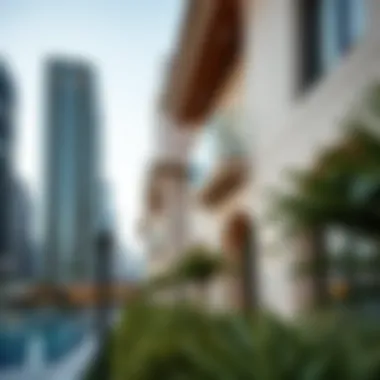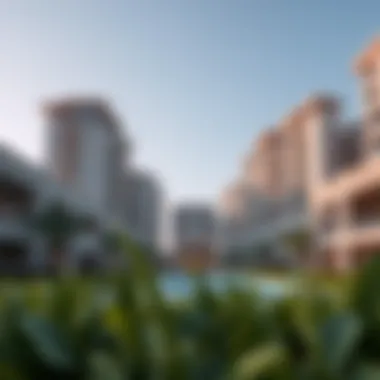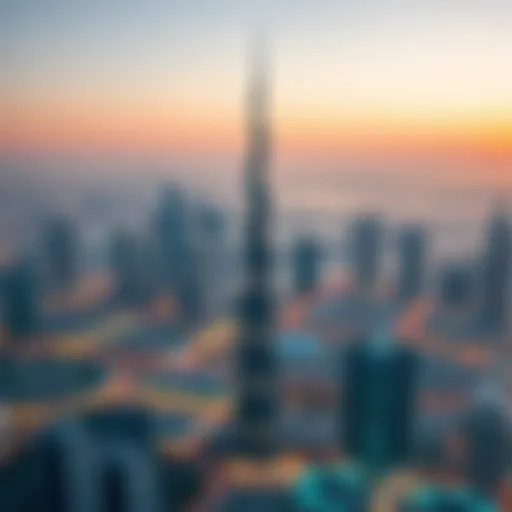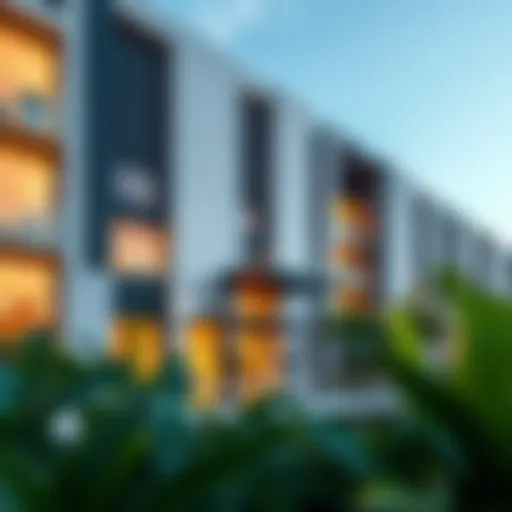Lifestyle Development Trends in Dubai Real Estate


Intro
As the sun sets over the iconic skyline of Dubai, one can't help but notice how the emirate has transformed into a global hub for both luxury and innovation in real estate. The intertwining of lifestyle development and property investments has become not just a trend, but a pivotal aspect of residential offerings. In a city where skyscrapers punctuate the horizon and opulent shopping malls line the streets, the expectations of homeowners and renters are shifting rapidly. This article delves deeply into this dynamic, exploring how the evolving lifestyle expectations shape Dubai’s real estate landscape.
Residents now seek more than just a roof over their heads; they desire a holistic living experience—one that caters to convenience, comfort, and community engagement. Developers are keen to meet these demands by integrating lifestyle amenities directly into their spaces. Whether it’s podium gardens that offer green retreats in high-rise buildings or smart home technologies that enhance Uber-comfort, the design ethos of new residential projects speaks volumes about the future of urban living.
This exploration is not just for investors looking to park their money in a robust market, but also for expats and locals alike who are navigating the complex web of property options and lifestyle benefits. From luxury beachfront villas to chic apartments in buzzing urban centers, the options continue to expand as Dubai's demographic shifts and diversifies. As we dig into this interplay of lifestyle and real estate, it’s crucial to highlight the significance of this evolution for a variety of stakeholders including buyers, property managers, and real estate agents.
Let’s embark on this journey of discovery, starting with the current market trends.
The Essence of Lifestyle Development
In the fast-paced world of Dubai's real estate, lifestyle development isn't just an added bonus; it's a fundamental pillar shaping the market. More than just places to live, lifestyle developments respond to changing preferences and expectations, recognizing that real estate is no longer solely about square footage but rather about experiences and community. In essence, integrating lifestyle into real estate transcends mere architecture. It encompasses spaces designed for holistic living where individuals can thrive socially, physically, and mentally. This shift reflects not only consumer demand but also a broader societal change prioritizing quality of life.
Understanding Lifestyle Development
Understanding lifestyle development involves recognizing the interplay between physical space and the nuanced needs of its inhabitants. Dubai's skyline is filled with stunning architectural feats, yet the true essence lies in how these buildings foster relationships and personal growth. Consider this: a resident in a state-of-the-art apartment complex isn't just looking for a roof over their head; they're seeking amenities that enhance leisure, promote health, and cultivate community. The design of these environments is tailored intentionally; they offer fitness centers, community gardens, and recreational areas that foster social engagement.
The market has evolved to acutely reflect this, particularly as the demographic landscape shifts. Young professionals and families increasingly prioritize a lifestyle that balances work and wellness. The integration of smart home technologies and sustainable practices further exemplifies this trend. It's about merging innovation with everyday life, allowing residents to not only reside but thrive within their spaces.
Historical Context of Lifestyle Trends in Dubai
The story of lifestyle development in Dubai cannot be told without appreciating its historical context. Over the last few decades, Dubai has transformed from a quiet trading port into a bustling metropolis that attracts global citizens. Driven by rapid economic growth, this transformation has influenced lifestyle preferences significantly.
In the early 2000s, lifestyle choices were often influenced by expatriate communities, whose diverse backgrounds brought varied expectations regarding living standards. As the city developed, so did the amenities alongside residential offerings, leading to enhanced facilities in housing schemes. From sprawling family-friendly communities to luxury high-rises equipped with every imaginable convenience, these trends reflect how Dubai has catered to an increasingly sophisticated audience.
Moreover, cultural shifts play a crucial role here. The city has emerged as a melting pot of cultures, creating a demand for spaces that reflect global standards while still respecting local traditions. The blend of modernity and tradition can be seen in community layouts that promote social interaction, aligning perfectly with the aspirations of both expatriates and locals. As such, understanding these historical influences is imperative for anyone looking to invest or engage in Dubai's real estate market.
"Lifestyle development in Dubai is an ever-evolving narrative, interwoven with the city’s rapid transformation and rich cultural tapestry."
Through the lens of lifestyle, one can truly appreciate the unique essence of Dubai's real estate—an arena where tradition meets modernity, and every brick contributes to a larger story of community and well-being.
Key Factors Influencing Lifestyle Development in Dubai
The realm of lifestyle development in Dubai is not a stagnant pool but a dynamic ocean, influenced by various currents. Understanding these key factors is crucial for anyone involved in real estate, from investors to expatriates. Each factor acts like a piece of a puzzle that, when put together, reveals the larger picture of how Dubai's lifestyle is shaped and, by extension, its real estate market.
There are three primary factors that contribute notably: socioeconomic conditions, technological advancements, and cultural shifts. These elements do not function in isolation; rather, they interact and influence one another, creating a rich tapestry that defines the lifestyle of residents and expatriates alike.
Whether it’s the bustling tech scene attracting young professionals or the cultural fabric that weaves together diverse communities, grasping these factors is essential. They not only dictate current trends but also provide insights for future developments, making them indispensable for strategic decisions in the property market.
Socioeconomic Factors
Socioeconomic conditions in Dubai can be likened to the weather—constantly changing and unpredictable. The high standard of living draws a diverse population, including affluent expatriates and wealthy locals. With a booming economy that capitalizes on tourism, trade, and finance, Dubai has become a magnet for investment.
- Income Levels: The expat community often sees higher disposable incomes, leading to increased demand for premium housing and lifestyle amenities.
- Population Growth: Continuous influx of residents fuels the need for new properties and fosters a competitive market environment.
These dynamics create opportunities but also challenges in terms of affordability and sustainable development. Prices can skyrocket, putting pressure on affordable housing. In essence, understanding these socioeconomic factors can illuminate the path for making prudent investment decisions.
Technological Advancements
Technological progress acts as the wind in the sails of lifestyle development in Dubai. The emergence of smart home technologies has redefined living spaces, transforming them into something straight out of a science fiction novel. Take a closer look at some trends:
- Smart Facilities: Homes equipped with automation features enhance security, energy efficiency, and comfort, appealing to tech-savvy residents.
- Infrastructure Innovations: The integration of AI in planning and construction processes optimizes resource allocation and builds resilience against various challenges.
The impact of technology doesn't stop at individual homes. It reflects in the overall urban planning and development that makes Dubai a frontrunner in lifestyle offerings. Hence, for anyone considering investment or property management in the region, keeping an eye on technological trends can pay off significantly.
Cultural Shifts
Cultural elements are deeply interwoven into the very fabric of Dubai. The Emirate is a melting pot of cultures, leading to a unique lifestyle that blends modernity with tradition. Understanding this can yield insights into consumer preferences:
- Diverse Community Needs: As people from all corners of the world settle in Dubai, there’s an increasing demand for varied lifestyle choices—from dining options to recreational facilities that cater to diverse backgrounds.
- Work-Life Balance: The changing values towards work-life balance over the years have heightened interest in mixed-use developments that combine residential, retail, and leisure facilities, allowing residents to fulfill their daily needs within a holistic environment.
The cultural shifts occurring in Dubai are more than just trends—they're indicators of what residents seek in their living spaces, which in turn affects property investment strategies.
In summary, recognizing these key factors can significantly inform real estate strategies, ensuring alignment with the evolving lifestyle expectations of Dubai's diverse population. For those navigating this vibrant market, these insights are not just beneficial—they are essential.
Innovations in Residential Design
The landscape of residential design in Dubai is ever-evolving, reflecting the region's rapid growth and diverse cultural influences. Innovations in design are not just about aesthetics; they encompass sustainability, technology, and community engagement, making them vital elements in shaping modern living. These innovations can drive property value, meet the needs of a dynamic population, and contribute to the overall quality of life. It’s essential for investors and stakeholders to understand these trends, as they have both long-term implications and immediate impacts on the market.


Smart Home Technologies
With the surge of technology, smart home systems have integrated into the very fabric of residential properties in Dubai. Homes outfitted with smart technologies offer residents unparalleled convenience and efficiency. These systems can regulate temperature, control lighting, and even manage security features all from a mobile device, ensuring comfort and safety at the touch of a button.
Moreover, energy-saving devices contribute significantly to lowering utility costs. Equipped homes attract tech-savvy buyers and investors alike, who are keen on modern living solutions. For instance, integration of energy-efficient appliances and LED lighting can not only save money but also enhance the marketability of a property. Builders who embrace these advancements often find themselves distinguishing their offerings in a competitive market.
"Smart homes are not just the future; they are, quite literally, enhancing living standards today."
Sustainable Building Practices
As environmental concerns take center stage, sustainable building practices are becoming a cornerstone in Dubai's residential design. By focusing on resource efficiency in the design, construction, and operation of buildings, developers can significantly impact the urban environment. Using sustainable materials and construction techniques not only reduces the carbon footprint, but also promotes a healthier living atmosphere.
Incorporating green roofs, rainwater collection systems, and solar panels into residential designs enhances energy efficiency and reduces environmental harm. Such features resonate with a growing population that values sustainability, making properties more appealing. Investors should note that these practices can lead to potential incentives, such as tax rebates or grants, ultimately increasing ROI.
Community-Centric Developments
The evolving nature of community living has paved the way for community-centric developments in Dubai. These projects emphasize connectivity and social interaction, creating spaces where people can live, work, and play together. This design philosophy recognizes the importance of shared spaces, parks, and recreational areas that not only enhance the aesthetic value of a neighborhood but also foster a sense of belonging among residents.
Community-oriented spaces can include everything from pedestrian-friendly pathways to communal gardens, establishing a lifestyle that mirrors the needs and preferences of modern residents. For investors, properties in these developments often command higher demand and, subsequently, a better return on investment. By aligning with the priorities of the current populace— social interaction and shared experiences—community-centric designs carve a niche that can stand the test of time.
The Role of Lifestyle Amenities in Property Investment
When delving into the world of property investment, the landscape becomes increasingly intricate, especially in a place like Dubai, which is a melting pot of cultures and expectations. Lifestyle amenities have taken on a pivotal role in driving property values upwards. Investors no longer gauge worth solely based on square footage or location; they are now meticulously considering the lifestyle options attached to their investments. The importance of lifestyle amenities cannot be overstated because they enhance the overall living experience, directly influencing buyers' and renters' decisions.
Health and Wellness Facilities
In this fast-paced desert metropolis, health and wellness amenities have evolved from a luxury to a necessity. Fitness centers, yoga studios, and wellness spas are not just valued features, but essential components of a lifestyle that many individuals aspire to maintain. Properties featuring such facilities attract health-conscious residents eager to lead balanced lives.
- Benefits: Not only do these amenities contribute to the physical well-being of residents, but they also create a sense of community. Residents bonding over fitness classes or spa days fosters social interaction.
- Considerations: Investors must consider how proximity to such facilities may influence property value. Premium listed apartments tend to be closer to gyms, swimming pools, or wellness centers. It’s worth noting that buyers often conduct thorough research into available health facilities before making a decision.
Leisure and Recreational Spaces
Leisure is a cornerstone of life in a busy city, and recreational amenities often sway buyers into making a purchase or a rental agreement. Parks, blend of beach access, and sentry fitness trails contribute dramatically to the quality of life.
- Importance of Open Spaces: Something as simple as access to parks can augment property value. Home-seekers now prefer developments that emphasize outdoor living, offering rightful escapes from the concrete jungle.
- Community Building: Leisure spaces can enhance a neighborhood's social fabric. Families, young professionals, and expatriates often gather in such areas, enhancing networking opportunities. A community that vibes well over leisure activities is generally more welcoming, leading to lower turnover rates among tenants.
Dining and Retail Options
In the culinary melting pot that is Dubai, access to quality dining and retail options shapes lifestyle perception spectacularly. Properties situated near popular restaurants, cafes, and shopping hubs undeniably draw attention.
- Consumer Preferences: Investors should acknowledge that modern consumers prioritize convenience. Nearby dining options can sway decisions, with many prospective buyers willing to pay a premium for properties close to dining experiences.
- Economic Impact: A strong retail environment not only contributes to lifestyle but also fosters economic growth. Areas abundant with dining options tend to attract larger crowds, increasing foot traffic and thereby enhancing property values.
"In Dubai, an excellent eating spot down the street can add significant value to a property, far beyond its initial worth."
With the factors above in mind, it becomes clear: lifestyle amenities are not just an add-on in Dubai’s real estate market; they are essential to driving property investments. Understanding these dynamics offers investors valuable insight into what modern buyers and renters are increasingly looking for, aiding in strategic decision-making ahead. For potential investors, recognizing the importance of these amenities can be a game changer in navigating Dubai’s competitive real estate landscape.
For more information on lifestyle integrations in real estate, visit Wikipedia and find deeper insights into current trends.
Analyzing Market Trends
Understanding market trends is crucial in the context of Dubai's real estate landscape. These trends not only inform investors and stakeholders about current conditions but also illuminate potential shifts in preferences and demands. Emphasizing this topic helps in grasping how various dynamics impact investment decisions, ultimately shaping the overall market environment.
Current Landscape of Dubai's Real Estate Market
The present landscape of Dubai's real estate is nothing short of fascinating. With its skyscrapers piercing the clouds, breath-taking villas, and vibrant communities, the market seems to pulsate with life. As of late 2023, experts have noted that property prices in certain districts are witnessing a modest rebound, largely driven by the influx of expatriates and a more stable regulatory framework.
- High Demand for Rental Properties: Many expatriates are making Dubai their home away from home. This has led to an increase in demand for rental properties, especially in areas like Dubai Marina and Downtown Dubai. Investors keen on rental yields should focus on these neighborhoods.
- Luxury Segment Flourishing: There has been a notable surge in demand for luxury real estate, especially from buyers from Europe and Asia. Developments such as Bluewaters Island and Palm Jumeirah are hot-ticket items.
- Technological Integration: Companies are increasingly prioritizing smart technologies in property developments. Homes equipped with IoT devices offer convenience and may command a premium price. Investors should assess how these technological advancements are likely to influence property values in the near future.
While the government is making strides in enhancing the market's infrastructure, understanding current trends assists investors in predicting future movements and making informed decisions. Market analysis today is not just about numbers; it's also about understanding the people who live and work in this vibrant city.
Future Projections for Lifestyle Developments
When peering into the crystal ball of Dubai's real estate market, future projections for lifestyle developments indicate transformative changes on the horizon. The blend of innovation, resilience, and sustainability will likely shape new developments.
- Emphasis on Green Living: There is an increasing inclination towards eco-friendly developments incorporating renewable energy sources and sustainable design practices. This aligns with global trends where environmentally-conscious living spaces are becoming a priority.
- Mixed-Use Developments: Future projects may lean towards mixed-use complexes that combine residential, commercial, and recreational spaces, fostering a community-centric living approach. Developments like Dubai Creek Harbour demonstrate this trend by integrating residential units with leisure and shopping facilities.
- Cultural Integration and Experience: Investors should analyze how developers plan to incorporate cultural nuances into their projects, such as art installations and spaces for local markets. These elements not only enrich the community but also enhance property attractiveness.
Legal and Regulatory Considerations
The legal and regulatory landscape in Dubai plays a crucial role in shaping the real estate market and influencing lifestyle development. Understanding these legal frameworks is essential, not only for investors and property developers but also for prospective home buyers and expatriates seeking to settle in this bustling metropolis. The implications of ownership laws and the overall regulatory environment can dictate everything from property prices to the types of lifestyle amenities that developers choose to incorporate into their projects.


Navigating the complexities of property laws can be akin to finding one's way through a maze. It often requires meticulous attention to detail, as even a small oversight can lead to significant financial implications. However, having a firm grasp of the legal landscape enhances the confidence of investors and reduces uncertainty in their investment decisions.
Whether you are an expatriate looking for a place to settle down or an investor aiming to capitalize on the growth potential of Dubai's real estate, awareness of the legal frameworks can be a game changer. It lays the groundwork for a successful property investment journey.
Ownership Laws in Dubai
Dubai's ownership laws set the stage for real estate transactions, shaping how properties can be bought, sold, and owned. One of the pivotal elements is the distinction between freehold and leasehold properties. Freehold ownership grants full rights to foreign buyers in designated areas, allowing them to own the property outright. Areas like the Palm Jumeirah and Downtown Dubai are typically characterized by freehold properties, making them attractive to investors.
On the other hand, leasehold properties allow expatriates to lease a property for a specified number of years, usually extending to 99 years. This arrangement is commonly found in older neighborhoods and presents an alternative for those who wish to invest in areas that may not offer freehold titles.
Some key points regarding ownership laws are:
- Freehold Areas: These locations permit foreigners to own property completely, marking them as prime investment zones.
- Leasehold Terms: Typically span 30 to 99 years, often requiring renewal discussions ahead of expiration.
- Regulatory Bodies: The Dubai Land Department plays a vital role, overseeing registration and ensuring legal compliance throughout property transactions.
Understanding these ownership specifics is paramount. It allows investors to strategize effectively, selecting properties that align with their investment goals and risk appetite.
Implications for Expatriates
For expatriates, the implications of Dubai's ownership laws can significantly affect their housing situations and long-term plans. Knowing where one can buy or lease property brings clarity and confidence, particularly in a foreign land. Particularly critical factors include access to financing, residency eligibility, and potential returns on investment.
- Access to Financing: Many banks in Dubai offer mortgages to expatriates, although terms may differ from those available to UAE nationals. Understanding these nuances can help expatriates secure the best possible deal.
- Residency Requirements: Owning property is often linked to residency visas, which can facilitate legal residency in Dubai for homeowners. This opens up pathways for job hunting and overall integration into the local community.
- Market Dynamics: Expatriates often drive demand in specific neighborhoods. Areas like Jumeirah Beach Residence often appeal due to proximity to leisure and social amenities.
This demographic influence brings about vibrant lifestyle developments that cater to a diverse set of preferences, shaping the overall living experience in Dubai.
By paying close attention to these implications, expatriates can better position themselves within the market. In doing so, they align their lifestyle choices with the opportunities available, leading to informed decisions that contribute to their quality of life in Dubai.
In summary, legal and regulatory considerations are fundamental in Dubai's real estate arena. With the right knowledge in hand, investors, expatriates, and property professionals can navigate the multifaceted landscape, enhancing their prospects in this dynamic market.
Challenges in Lifestyle Development
Navigating the challenges of lifestyle development in Dubai's real estate market is not just important—it's essential. As the city continues to grow and diversify, the balance between new developments and existing cultural values comes under scrutiny. These challenges can significantly impact everything from investment decisions to community satisfaction.
Balancing Tradition and Modernity
In a city like Dubai, where the sands of time meet cutting-edge architecture, finding common ground between tradition and modernity can feel like a tightrope walk. On one hand, there’s an incessant push for innovation: think of the dazzling Burj Khalifa and the sprawling Dubai Marina. Yet, on the other hand, cultural heritage plays an equally vital role, evidenced by the preservation of historical districts like Al Fahidi.
Developers are tasked with creating spaces that reflect this duality.
- Integration of Traditional Elements: Projects are increasingly incorporating features such as Arabic calligraphy, mashrabiya screens for shading, and local landscaping that connects the new with the historical.
- Community Involvement: Engaging with residents during the planning phase often bears fruit. Residents can voice concerns or ideas related to how a development reflects both the local culture and modern conveniences.
The challenge remains: how to innovate while respecting the city's roots. Investors should keep an eye on this balance, as projects that neglect local values may face backlash, ultimately affecting their viability and market appeal.
Addressing Environmental Concerns
As Dubai strives to be a beacon of sustainability, environmental concerns penetrate the core of lifestyle development. The rapid pace of construction brings about unique challenges, as development often seems to clash with ecological principles.
- Water Scarcity: Dubai, sitting in a desert, faces natural resource limitations. Developers are now looking to incorporate water-saving technologies, such as greywater recycling systems, into their projects.
- Green Building Standards: The UAE has launched several initiatives like the Estidama Pearl Rating System that urge developers to adopt sustainable practices. Using materials that minimize energy consumption, and designing buildings that can withstand the harsh climate, are now more than just recommendations; they are keys to market competitiveness.
Environmental responsibility is also closely tied to the perception of a development. Buyers are increasingly prioritizing homes that reflect their values concerning sustainability.
“In today’s market, green features can add significant value to properties. Studies indicate that homes with sustainable designs tend to fetch higher prices.”
Addressing these environmental concerns within lifestyle developments offers more than just aesthetic appeal; it stands to enhance long-term profitability. This intersection of lifestyle and environmental responsibility can be a make-or-break factor for investors navigating Dubai’s dynamic market.
The Impact of Global Economic Factors
Understanding the global economic climate is crucial when discussing lifestyle development in Dubai's real estate market. This region, particularly Dubai, has positioned itself as a prime destination for investment and relocation. The interweaving of international markets, economic policies, and local market dynamics creates a unique tapestry that influences property investments.
The real estate sector in Dubai thrives on a cocktail of local ambition and international interest. Investors from all over the globe see Dubai as a golden opportunity, yet shifts in global economic factors can cause ripples in what can seem like a steady sea of growth. Expats, agents, and potential investors need to remain acutely aware of these global dynamics to navigate the local landscape effectively.
Influence of International Markets
The connection between Dubai and international markets is tighter than a drum. When foreign economies flourish, the influx of capital into Dubai’s real estate sector often increases. For example, a surge in the European market can significantly boost property sales, as investors seek warm weather and investment diversification in a city that epitomizes luxury living.
Moreover, shifts in market sentiment can alter investment strategies. Prioritizing emerging markets—like some regions in Southeast Asia—may shift investor focus, causing make-or-break moments for Dubai's property landscape. Key indicators to watch include:
- Currency fluctuations: For instance, the strength of the US dollar can impact buying decisions in Dubai, especially as many transactions occur in this currency.
- Economic recovery indicators: News from major economies can either encourage investment in Dubai or lead potential investors to tighten their belts, depending on forecasts.
"Economic conditions in one part of the world can create a domino effect across continents."


Response to Economic Fluctuations
When the economy takes a downturn, properties that were previously hot commodities can languish. For investors, recognizing these fluctuations is essential in timing their investments. Areas like Downtown Dubai, where prestigious developments are housed, can see property values shift dramatically. Moreover, a response plan becomes paramount when facing economic instability. Investors may need to:
- Diversify portfolios: In uncertain times, spreading investments across various types of properties can cushion against local market drops.
- Evaluate rental yields: The rental market often reacts differently than the sales market, making it crucial to track trends closely.
- Maintain cash flow: A robust financial structure helps investors retain holdings during downturns without the compulsion to sell at a loss.
By keeping an ear to the ground about global economic conditions, savvy investors can better position themselves to capitalize on both booms and downturns in the real estate market. Understanding these intricate dynamics enables stakeholders in Dubai’s real estate market to make informed decisions that align with their financial goals.
Case Studies in Lifestyle Development
Case studies in lifestyle development within the context of Dubai's real estate provide valuable insights into how different projects can cater to evolving resident preferences and shape the fabric of urban living. They serve not only as a testament to successful design and planning but also offer a lens through which to evaluate missteps that can lead to shortcomings in the market. Investing time to analyze these examples can shed light on best practices, potential pitfalls, and the dynamics at play in one of the world’s most vibrant real estate hubs.
Successful Projects in Dubai
In recent years, Dubai has seen a plethora of successful lifestyle developments that have captured the imagination of both locals and expats. Projects like Emaar's Downtown Dubai stand out, showcasing a blend of luxury living, retail spaces, and leisure amenities—all in one integrated environment. The development is not just a collection of high-end condo towers; it transforms community engagement through spaces like the Dubai Mall and the impressive Burj Khalifa.
Another noteworthy example is Arabian Ranches, which offers a suburban feel while being just a stone's throw away from the hustle and bustle of the city. This neighborhood appeals to families with its ample green spaces, schools, and recreational facilities. The design philosophy here rests on fostering a sense of community, where residents can enjoy a balanced lifestyle.
Not to be forgotten, the Jumeirah Beach Residence exemplifies how waterfront living can flourish, combining residential, commercial, and recreational areas. It emphasizes leisure, with access to beaches, parks, and a vibrant promenade that promotes both socializing and a healthy lifestyle. Residents often find themselves living where the action is, with an array of dining options and beach activities just a short walk away.
These successful projects embody the growing trends in lifestyle development—balancing elegance with functionality. Their resonance illustrates how effectively integrating lifestyle amenities can significantly enhance property value, making them attractive for potential investors and homebuyers alike.
Lessons Learned from Failed Developments
On the flip side, not every project has weathered the storm of Dubai's unpredictable real estate market. Analyzing failed developments can yield invaluable lessons about consumer preferences and the consequences of ignoring them. One infamous example is the Dubai Pearl, a luxury development planned to revolutionize the local landscape but eventually stalled due to financial mismanagement and unmet expectations. Its original promise of a thriving urban hub fell flat as investors lost faith in the project’s viability.
Additionally, projects like the Dubai Waterfront have faced their own challenges. Initially envisioned as a premier waterfront community, it has struggled with delays and market shifts that left it half-completed and, ultimately, a shadow of its ambitious goals. Such cases highlight the importance of robust market research and understanding the target demographic when embarking on new developments. If planners failed to consider the lifestyle needs and desires of potential residents, the results can indeed be disheartening.
In retrospect, the successful ventures have often embraced community engagement and transparency with stakeholders, while the unsuccessful ones fell short in communication and adaptability. Understanding these factors can be crucial for future investors, agents, and developers, guiding them away from common pitfalls and steering them towards strategies that resonate with Dubai’s cosmopolitan populace.
By examining both successful projects and failures, stakeholders gain a well-rounded picture of what drives lifestyle development in Dubai, aiding them in making informed decisions in a complex and ever-evolving real estate landscape.
"Success in Dubai's real estate hinges not just on architecture, but deeply on understanding the lifestyle ethos of its residents."
\ Learn more about successful urban developments and the lessons learned from various ventures by visiting Wikipedia, Britannica for comprehensive insights.
Practical Insights for Investors
In the dynamic landscape of Dubai's real estate, investors are on a perpetual quest for the next big opportunity. Understanding lifestyle development trends can serve as a compass for those navigating this intricate market. The aim here is to provide practical insights that can guide potential investors towards making informed decisions.
Identifying Promising Projects
When it comes to spotting a promising development project, several factors ought to be taken into account. Investors should begin by looking at location. Areas such as Dubai Marina or Downtown Dubai are known for their vibrant lifestyle offerings, making them attractive to both tenants and buyers. Key sub-factors might include proximity to essential amenities such as schools, healthcare facilities, and leisure options.
Consider also the reputation of the developer. Established companies like Emaar Properties and Damac Properties have a track record of delivering quality products on time. Investors need to delve into past projects to gauge reliability and trustworthiness. More importantly, understanding the financial health of the developer can also reveal the sustainability of their projects.
According to recent trends, mixed-use developments have gained traction—a trend that investors should closely follow. These are not mere residential complexes; they often combine residential, commercial, and retail spaces into a community-centric model. The appeal of mixed-use spaces can lead to higher occupancy rates and, consequently, better returns on investment. Look for projects that showcase this integration.
Evaluating Lifestyle Factor Importance
In today’s day and age, lifestyle factors are paramount to the decision-making process of many potential buyers and renters. Therefore, assessing these elements early on can provide a huge advantage. First and foremost, investors should evaluate amenities that promote well-being, such as fitness centers, swimming pools, and parks. Properties that cater to health-conscious individuals are often in higher demand.
Furthermore, consider the quality of lifestyle services offered. Features like 24/7 concierge services, valet parking, and smart home technologies are increasingly attractive. Investing in properties that offer such convenience can make a substantial difference. As reported by various sources, buyers are becoming more discerning, placing significant weight on lifestyle offerings in their choices.
In addition to physical amenities, look at the projected lifestyle trends in the community. For instance, with the rise of remote working, demand for properties that offer dedicated home office spaces is on the upswing. Understanding these societal shifts can provide an edge in the real estate market. Keeping your ear to the ground on emerging lifestyle trends could save investors from potential missteps.
"Investments in lifestyle-aligned properties often yield better long-term returns due to rising consumer expectations."
Epilogue
The importance of the conclusion in this article lies in its ability to synthesize the comprehensive insights gathered throughout the exploration of lifestyle development within Dubai's real estate landscape. As the city continues to morph into a global hub attracting investors, expatriates, and professionals alike, understanding the nuances of lifestyle dynamics becomes critical. This final section aims to summarize key takeaways while looking ahead to future trends that both investors and residents need to consider.
Summary of Key Insights
Throughout this article, several pivotal insights have emerged, shaping our understanding of lifestyle development in Dubai:
- Integration of Lifestyle Amenities: The modern property market increasingly intertwines residential spaces with lifestyle amenities, such as fitness centers, parks, and dining options. Homes are no longer just for living; they offer a holistic experience.
- Cultural Influence: Dubai's multicultural environment significantly impacts lifestyle expectations. With a diverse population, developments that cater to a variety of cultural preferences have gained traction, emphasizing inclusivity.
- Technological Innovations: Smart home technologies and sustainability considerations now play an essential role in property value, enhancing both comfort and ecological responsibility.
- Market Dynamics: The ebb and flow of international markets directly influence local investments. Investors need to stay abreast of global economic factors that can reshape the property landscape.
Future Outlook for Lifestyle Development
As we turn the lens to the future, several considerations emerge regarding the trajectory of lifestyle development in Dubai:
- Emergence of New Neighborhoods: As Dubai's population continues to grow, there will be a rising demand for innovative developments in areas currently less populated. Developers may seek to design projects that incorporate elements of communal living.
- Sustainability Initiatives: Expect a greater emphasis on eco-friendly practices. Developments that prioritize green spaces, energy-efficient homes, and sustainable materials will likely attract a more conscientious demographic.
- Technological Integration: Advancements in technology will continue to shape living spaces. Increased automation and smart city planning may redefine traditional concepts of neighborhoods.
- Global Economic Shifts: With the world becoming more interconnected, changes in international economies can influence local investments, making it essential for stakeholders to remain agile in their strategies.
In sum, the future of lifestyle development in Dubai promises a blend of tradition and innovation, aimed at enhancing the quality of life for its residents while providing lucrative opportunities for savvy investors. Understanding these dynamics allows for informed decision-making, positioning investors and property professionals at the forefront of an ever-evolving market.











